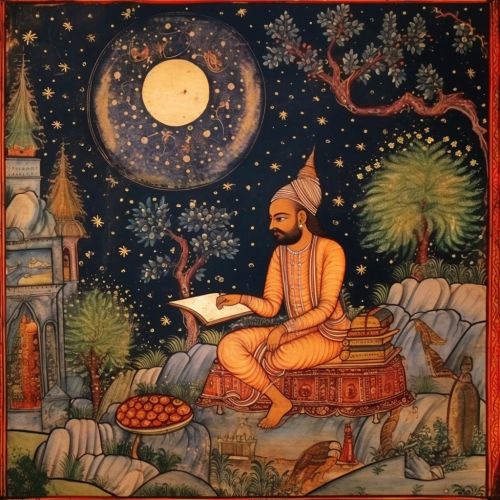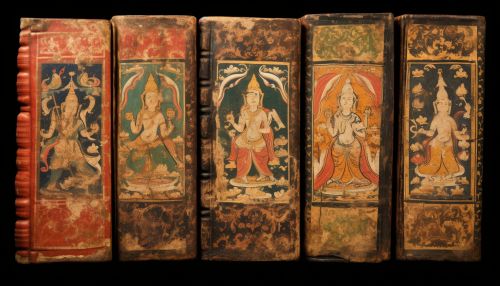Hindu Literature
Introduction
Hindu literature, one of the oldest known literatures in the world, is a vast and varied body of texts composed in different languages and spanning many centuries. This literature encompasses a wide array of genres, including religious texts, philosophical treatises, epic narratives, poetry, drama, and scientific works. It has significantly influenced the cultural, religious, and philosophical development of the Indian subcontinent and has left a lasting imprint on world literature.


Origins and Development
The origins of Hindu literature can be traced back to the ancient Vedic period (c. 1500 – c. 500 BCE), with the composition of the four Vedas – the Rigveda, Yajurveda, Samaveda, and Atharvaveda. These texts, written in Sanskrit, form the foundation of Hindu philosophy, rituals, and beliefs. The Vedas are considered Shruti literature, meaning they are believed to be divinely revealed and are held in the highest regard in Hindu tradition.
Following the Vedic period, the Upanishadic period (c. 800 – c. 200 BCE) saw the development of philosophical texts that explored the concepts introduced in the Vedas. These texts, collectively known as the Upanishads, are considered the end part of the Vedas (Vedanta) and delve into topics such as the nature of reality, the self, and ultimate truth (Brahman).
The Mahabharata and the Ramayana, two major Sanskrit epics, were composed during the Epic and Puranic period (c. 500 BCE – c. 500 CE). These works are not only significant literary achievements but also important religious and philosophical texts. The Mahabharata, attributed to the sage Vyasa, is the longest epic poem in the world and includes the Bhagavad Gita, a crucial text in Hindu philosophy. The Ramayana, attributed to the sage Valmiki, narrates the life and adventures of Prince Rama.
During the Classical period (c. 500 – c. 1500 CE), Sanskrit literature flourished with the creation of works in drama, poetry, and prose. This period saw the rise of Kavya (poetic) literature, with poets like Kalidasa, Bhasa, and Bharavi producing renowned works. The period also witnessed the composition of the Puranas, a genre of ancient Indian scriptures that narrate the history of the universe from creation to destruction.
Hindu literature continued to evolve in the medieval period (c. 1500 – c. 1800 CE), with the development of regional languages and literatures. This period saw the creation of devotional (Bhakti and Sufi) literature in languages such as Tamil, Telugu, Kannada, Bengali, and Marathi. Saints and poets like Kabir, Tulsidas, Mirabai, and Tukaram contributed significantly to this body of literature.
In the modern period (c. 1800 CE – present), Hindu literature has continued to grow and diversify, reflecting the changing socio-political and cultural contexts of the times. This period has seen the emergence of novelists, poets, and playwrights writing in English and various regional languages, who have made significant contributions to Indian and world literature.
Genres of Hindu Literature
Hindu literature encompasses a wide range of genres, each with its unique characteristics and significance.
Shruti Literature
Shruti literature, considered the most authoritative, includes the Vedas and the Upanishads. These texts are regarded as eternal truths revealed to ancient sages (Rishis) during deep meditation. The Vedas are further divided into four types: the Samhitas (mantras and hymns), the Brahmanas (ritualistic texts), the Aranyakas (transition texts), and the Upanishads (philosophical texts).
Smriti Literature
Smriti literature, considered less authoritative than Shruti, includes texts that are remembered and transmitted across generations. These include the Dharma Shastras (law books), the Itihasas (epics), and the Puranas (ancient stories). The two major epics, the Mahabharata and the Ramayana, are part of Smriti literature.
Agama and Tantra Literature
Agama and Tantra literature provide guidelines for temple construction, idol installation, and worship procedures. These texts are particularly important in the Shaiva, Shakta, and Vaishnava traditions.
Darshana Literature
Darshana literature encompasses the philosophical systems of Hinduism, known as the six schools of philosophy (Shad-Darshanas). These include Nyaya, Vaisheshika, Samkhya, Yoga, Mimamsa, and Vedanta.
Kavya Literature
Kavya literature refers to the classical poetry and drama produced during the Gupta period. This genre includes the works of celebrated poets and playwrights like Kalidasa, Bhasa, and Bharavi.
Bhakti and Sufi Literature
Bhakti and Sufi literature, composed during the medieval period, express devotional sentiments towards various deities. This genre includes the works of saints and poets like Kabir, Tulsidas, Mirabai, and Tukaram.
Influence and Legacy
Hindu literature has had a profound influence on the cultural, philosophical, and religious landscape of the Indian subcontinent. It has shaped the beliefs, values, and practices of millions of people over the centuries. The philosophical concepts, moral teachings, and mythological narratives found in these texts continue to permeate various aspects of Indian society, including art, music, dance, theatre, and cinema.
Beyond the Indian subcontinent, Hindu literature has also made significant contributions to world literature. The themes, narratives, and characters found in the epics and other texts have inspired countless adaptations, reinterpretations, and translations in various languages and cultures around the world. The philosophical and spiritual insights offered by these texts have also attracted the interest of scholars, philosophers, and spiritual seekers worldwide.
